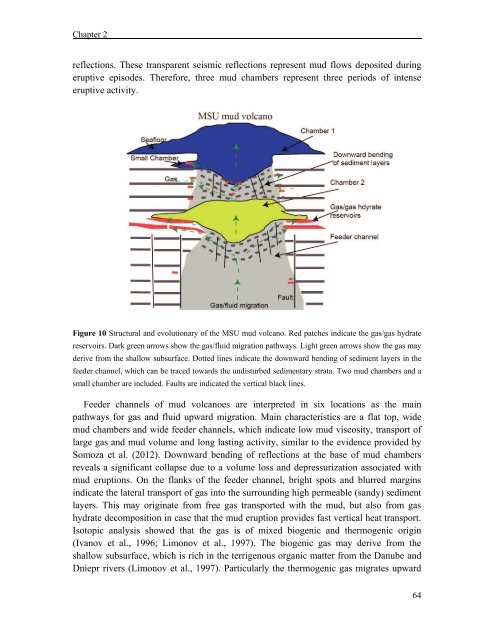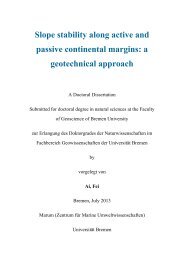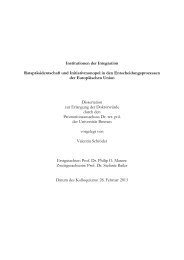Seismoacoustic Study of the Shallow Gas Transport and ... - E-LIB
Seismoacoustic Study of the Shallow Gas Transport and ... - E-LIB
Seismoacoustic Study of the Shallow Gas Transport and ... - E-LIB
You also want an ePaper? Increase the reach of your titles
YUMPU automatically turns print PDFs into web optimized ePapers that Google loves.
Chapter 2<br />
reflections. These transparent seismic reflections represent mud flows deposited during<br />
eruptive episodes. Therefore, three mud chambers represent three periods <strong>of</strong> intense<br />
eruptive activity.<br />
Figure 10 Structural <strong>and</strong> evolutionary <strong>of</strong> <strong>the</strong> MSU mud volcano. Red patches indicate <strong>the</strong> gas/gas hydrate<br />
reservoirs. Dark green arrows show <strong>the</strong> gas/fluid migration pathways. Light green arrows show <strong>the</strong> gas may<br />
derive from <strong>the</strong> shallow subsurface. Dotted lines indicate <strong>the</strong> downward bending <strong>of</strong> sediment layers in <strong>the</strong><br />
feeder channel, which can be traced towards <strong>the</strong> undisturbed sedimentary strata. Two mud chambers <strong>and</strong> a<br />
small chamber are included. Faults are indicated <strong>the</strong> vertical black lines.<br />
Feeder channels <strong>of</strong> mud volcanoes are interpreted in six locations as <strong>the</strong> main<br />
pathways for gas <strong>and</strong> fluid upward migration. Main characteristics are a flat top, wide<br />
mud chambers <strong>and</strong> wide feeder channels, which indicate low mud viscosity, transport <strong>of</strong><br />
large gas <strong>and</strong> mud volume <strong>and</strong> long lasting activity, similar to <strong>the</strong> evidence provided by<br />
Somoza et al. (2012). Downward bending <strong>of</strong> reflections at <strong>the</strong> base <strong>of</strong> mud chambers<br />
reveals a significant collapse due to a volume loss <strong>and</strong> depressurization associated with<br />
mud eruptions. On <strong>the</strong> flanks <strong>of</strong> <strong>the</strong> feeder channel, bright spots <strong>and</strong> blurred margins<br />
indicate <strong>the</strong> lateral transport <strong>of</strong> gas into <strong>the</strong> surrounding high permeable (s<strong>and</strong>y) sediment<br />
layers. This may originate from free gas transported with <strong>the</strong> mud, but also from gas<br />
hydrate decomposition in case that <strong>the</strong> mud eruption provides fast vertical heat transport.<br />
Isotopic analysis showed that <strong>the</strong> gas is <strong>of</strong> mixed biogenic <strong>and</strong> <strong>the</strong>rmogenic origin<br />
(Ivanov et al., 1996; Limonov et al., 1997). The biogenic gas may derive from <strong>the</strong><br />
shallow subsurface, which is rich in <strong>the</strong> terrigenous organic matter from <strong>the</strong> Danube <strong>and</strong><br />
Dniepr rivers (Limonov et al., 1997). Particularly <strong>the</strong> <strong>the</strong>rmogenic gas migrates upward<br />
64
















